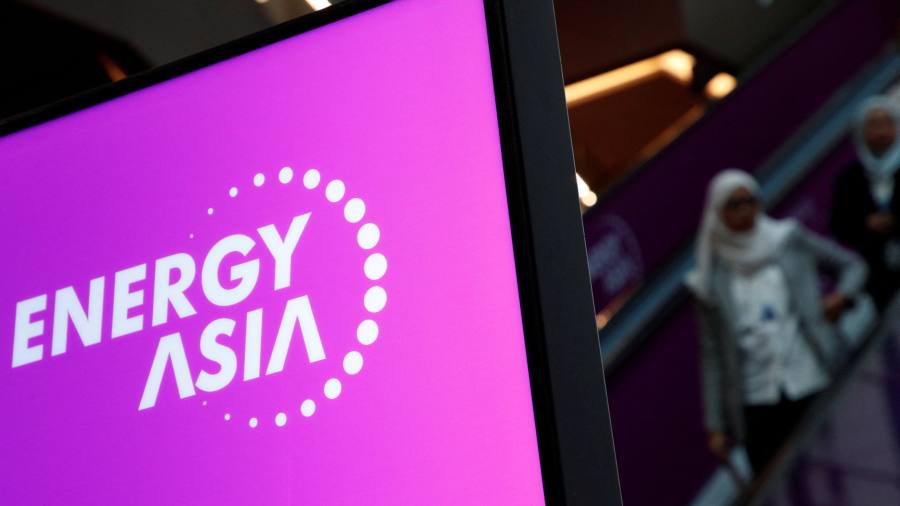
Receive free Natural gas updates
We’ll send you a myFT Daily Digest email rounding up the latest Natural gas news every morning.
Surging European demand for liquefied natural gas to offset the loss of piped Russian gas has pushed prices for the commodity beyond the reach of many buyers in lower income regions such as south and south-east Asia, driving some of them back towards a heavy dependence on coal, industry leaders said.
“Obviously Europe needs to grab as much gas as they could because they lost all that pipeline gas” from Russia, Russell Hardy, chief executive of Vitol, the world’s largest independent energy trader, told the Energy Asia conference in Kuala Lumpur, Malaysia.
“Europe’s thirst for LNG has taken some permanent supply from Asia, plus all the new supply from the US and absorbed it all,” Hardy said on the event’s opening day last month. “Asia in 2023 will still be accessing [LNG] . . . but the price will be much higher.”
Asian LNG spot prices have dropped from their record high of $70 per million British thermal units last August. Benchmark Japan/Korea Marker prices averaged $18 per million Btu between January and March, according to the International Energy Agency, and have fallen further in recent weeks. But the prices remain historically high and could go up again if winter in Europe turns out to be harsher than the mild previous one.
Hardy said the high prices were suppressing Asia’s LNG consumption, which is projected to increase from 252 million tonnes in 2022 to 260 million tonnes this year — still lower than 272 million tonnes in 2021.
“Asia is accessing today less gas than it could access in 2021,” he said. “That’s one sort of indication of inequality.”

Europe averted an energy crisis last winter with new LNG supplies from the US and Qatar, which have emerged as the world’s two largest gas providers as Russia has dramatically reduced its pipeline gas supply for Europe after its invasion of Ukraine.
Speakers at the conference, however, stressed that an LNG crisis had hit some lower-income markets instead.
“The message from European policymakers is, ‘We handled this situation well, we avoided blackouts’,” said Michael Stoppard, global gas strategy lead at S&P Global. “But actually there were blackouts. The blackouts were in certain markets in Asia, particularly in south Asia, where the LNG was diverted away to the higher-paying European markets.”
Patrick Pouyanné, chair and chief executive of French oil major TotalEnergies, said Asia overall had been fundamental for global LNG market growth. Seen as a fuel for the energy transition prior to the recent market disruptions, LNG consumption had been rising in the region as it attempted to reduce its heavy reliance on coal.
“And then [Europe] took some LNG from Bangladesh, Vietnam, Thailand and prices [went] up,” Pouyanné said. “We pushed these countries to need more coal.”
“I hope Europe will be good again, warmer” in the coming winter, he added, “because otherwise there’s no other way than to take more” energy from Asia.

This article is from Nikkei Asia, a global publication with a uniquely Asian perspective on politics, the economy, business and international affairs. Our own correspondents and outside commentators from around the world share their views on Asia, while our Asia300 section provides in-depth coverage of 300 of the biggest and fastest-growing listed companies from 11 economies outside Japan.
Subscribe | Group subscriptions
Octávio Simões, president and chief executive of US natural gas producer Tellurian, said Pakistan, Sri Lanka, Indonesia and even Japan and South Korea burned a lot more coal than they did before because they were deprived of affordable LNG supplies.
“And some countries like Pakistan [are] completely abandoning their long-term strategy of natural gas and deciding to develop their reserves of coal,” Simões said.
Tengku Muhammad Taufik, president and group chief executive of Malaysian state oil company Petronas, raised concerns over the long-term sustainability of natural gas supply in the region with the current “under-investment” situation in the oil and gas sector.
He said some financial institutions were worried that money put into oil and gas projects would be stranded capital. In the meantime, as other industry leaders said, renewable energy developments and decarbonisation efforts among energy companies in Asia have not progressed as fast as expected.
A version of this article was first published by Nikkei Asia on June 27. ©2023 Nikkei Inc. All rights reserved.